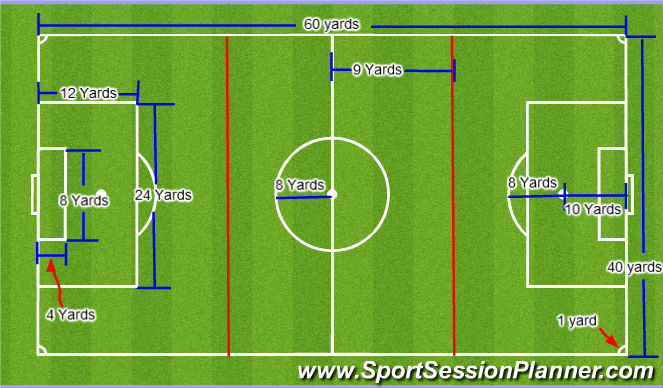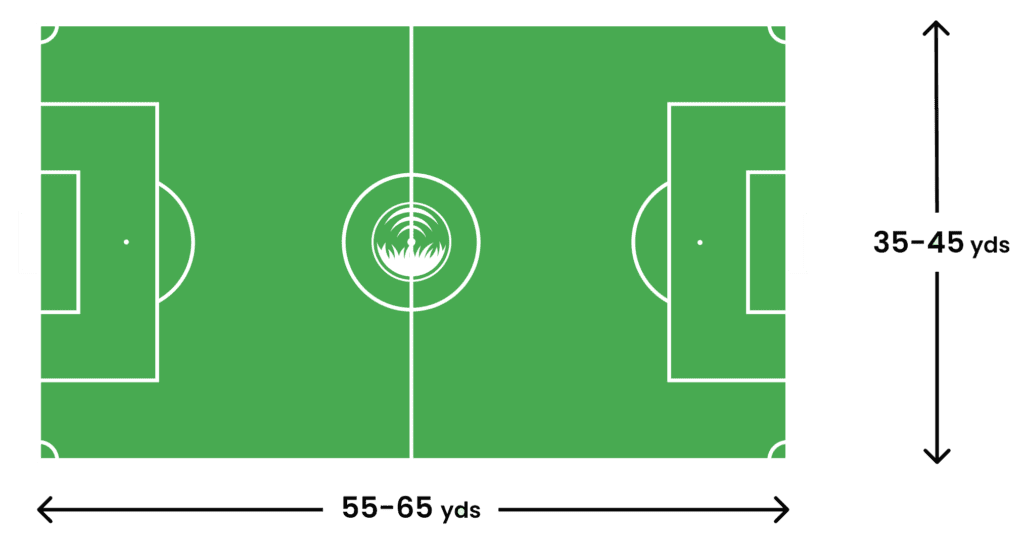7v7 soccer fields typically measure 55–65 yards in length and 35–45 yards in width. These dimensions make for a smaller, more tactical game suited for youth and amateur teams.
Understanding the layout of a 7v7 soccer field is crucial for players, coaches, and enthusiasts interested in the developmental stages of soccer. The smaller dimensions focus on skill development, quick decision-making, and technical aspects of play. Coaches use these scaled fields to teach young athletes the fundamentals of soccer in a less physically demanding space than a full-sized pitch.
This field size is not only manageable for youth leagues but also makes for exciting, fast-paced games that keep both players and spectators engaged. With a clear emphasis on player involvement and ball touches, the 7v7 field serves as a stepping stone to the larger 11v11 format, ensuring a smoother transition for budding soccer talent.
🔴7V7 Soccer Field Dimensions🔴

Table of Contents
Unveiling The 7v7 Soccer Game
Exploring the dynamic world of 7v7 soccer, a thrilling variation of the traditional sport that has captured the hearts of players and fans alike. With its unique field dimensions and gameplay strategies, 7v7 introduces a faster-paced, more accessible form of soccer. This guide dives into the specifics of the 7v7 soccer field, highlighting how its size shapes the way the game is played. Get ready to understand the finer points of this exciting format!
Core Differences From Traditional Matches
7v7 soccer stands apart with several key modifications:
- Smaller team sizes: 7 players, including the goalkeeper.
- Reduced field size: Offers quick, high-energy play.
- Shortened match times: Leads to faster game dynamics.
- Focused player development: More touches, better skill refinement.
Each element enhances player engagement and fun, emphasizing skill development and teamwork.
The Rise Of The 7v7 Format
The 7v7 game has gained popularity for its:
- Accessible nature, allowing teams to form and compete easily.
- Adaptability to different age groups and skill levels.
- Focus on technical skills, as players have more space and time.
- Suitable for coaching strategies that focus on player involvement.
As more players seek exciting, skill-centric play, 7v7 soccer has become a staple in training and recreational leagues.
The Importance Of Field Dimensions
Field dimensions play a pivotal role in 7v7 soccer, shaping the dynamic of the game. The size of the pitch impacts player movement, ball control, and overall match tempo. With appropriate spacing, teams can execute strategies effectively and develop skills optimally. Field dimensions set the stage for fair competition, ensuring players and teams can perform to the best of their abilities.
Impact On Gameplay And Tactics
Field dimensions directly influence how 7v7 soccer unfolds. On a pitch with the right size, players have enough room to maneuver, pass, and strategize. Let’s break down how field size impacts gameplay:
- Bigger spaces allow for longer passes and more tactical depth.
- Smaller areas increase the pace and require quick thinking.
- Properly sized goals ensure goalkeepers have the right challenge.
Teams must adapt their tactics based on the field’s size. Key points include:
- On a large field, teams favor a possession-based approach.
- In tighter spaces, a high-pressing strategy may work better.
Standardization Across Leagues
Uniform field dimensions across leagues are crucial for consistency in 7v7 soccer. Here are the benefits:
| Advantage | Description |
|---|---|
| Level Playing Field | Teams compete under the same conditions, making games fair. |
| Player Development | A consistent playing environment fosters skill progression. |
| Game Integrity | Standardized dimensions maintain the game’s essence and challenge. |
Leagues agree on specific dimension ranges to ensure fairness. These ranges usually include:
- Field length: between 55-65 yards
- Field width: between 35-45 yards
- Goal size: usually 6 x 18 feet
This standardization helps players transition smoothly between leagues and tournaments. With familiar field dimensions, teams focus on showcasing their skills and competitive spirit.
The Standard 7v7 Field Layout
Understanding 7v7 soccer field dimensions is crucial for players, coaches, and fans. The layout is designed to suit the smaller team size, providing ample space for play while maintaining a challenging environment. Let’s dive into the specifics.
Length And Width Specifics
The standard 7v7 soccer field is marked by its distinct size. Fields may vary slightly but follow general guidelines. See the typical measurements:
- Length: 55-65 yards
- Width: 35-45 yards
These dimensions create a balanced area for youth and adult leagues to develop skills and enjoy the game.
Penalty Area And Goal Size
Key areas of the field include the penalty box and the goal. Essential details are:
| Area | Dimension |
|---|---|
| Penalty Area | 14 yards from the goal line |
| Goal Size | 6 feet high, 18 feet wide |
The right proportions ensure fair play and adherence to regulation standards.
Comparing To Other Soccer Field Sizes
Understanding the dimensions of a 7v7 soccer field sheds light on the strategic differences in play style and pace that players experience. A 7v7 field is smaller than a standard 11v11 pitch yet larger than a 5v5 field. Knowing these size variations helps coaches and players adapt to the spaces and rules of different-sized games. Let’s explore how 7v7 soccer fields compare to 5v5 and 11v11 dimensions, and the modifications required for various age groups and league types.
5v5 And 11v11 Dimensions Contrast
5v5 soccer fields are the smallest in regulated play, designed for quick, close-quarters action. Common dimensions for 5v5 fields are approximately 25-35 yards in width and 35-45 yards in length. Conversely, 11v11 fields echo the international standards used in professional play. These expansive pitches are about 50-100 yards wide and 100-130 yards long. The 7v7 soccer field rests comfortably in between, typically extending 45-55 yards in width and 70-80 yards in length, marrying the intimacy of small-sided games with the strategy of full-sized matches.
| Field Type | Width (Yards) | Length (Yards) |
|---|---|---|
| 5v5 | 25-35 | 35-45 |
| 7v7 | 45-55 | 70-80 |
| 11v11 | 50-100 | 100-130 |
Modifications For Youth And Adult Leagues
Youth leagues often require modified field dimensions to suit player development and safety. Smaller fields ensure that young players can enjoy more touches on the ball and better manage the space. A typical youth 7v7 field might be on the lower end of the range, often around 45 yards wide by 65 yards long. Adult leagues, however, tend to use larger dimensions within the given ranges. The increased space accommodates the adult players’ advanced skills and physical capabilities. These adaptations ensure that the game remains challenging and enjoyable for all age groups. Common modifications include:
- Reduced field size for youth leagues
- Adjusted goal size to match player scale
- Flexible boundaries for multipurpose fields
In summary, the 7v7 soccer field serves as a versatile middle ground in dimensions, enabling a unique gameplay experience distinct from both 5v5 and 11v11 formats.
Setting Up A 7v7 Field
Setting up a 7v7 soccer field is essential for a great game. The right dimensions make play enjoyable and fair. Let’s dive into how to create the perfect 7v7 soccer field.
Equipment And Space Requirements
Before marking your field, gather the necessary tools. You’ll need:
- Measuring tape: Essential for precise field dimensions.
- Soccer goals: Two goals, each 6 feet high and 18 feet wide.
- Field marking paint: Choose a color that stands out on grass.
- Corner flags: Four flags to mark the field corners.
Space is crucial. A 7v7 field is smaller than standard. Look for a level area about 55-65 yards long and 35-45 yards wide.
Marking The Field: A Step-by-step Guide
- Measure the length: Start with the longer sides, 55-65 yards apart.
- Mark the width: Connect the ends to create a rectangle, 35-45 yards wide.
- Draw the goal area: Set it to 6 yards from each goal post and 6 yards into the field.
- Add the penalty area: It should lie 14 yards from each goal post and 14 yards into the field.
- Position the goals: Centre them on each goal line.
- Paint the markings: Use your field marking paint to draw clear lines.
- Insert corner flags: At each corner, place a flag to complete the setup.
Double-check your measurements for a perfectly sized field.

Rules Unique To The 7v7 Playing Field
Playing soccer on a 7v7 field brings its own set of rules. These rules create a unique game dynamic. Understanding these rules is crucial for players, coaches, and fans alike. This post focuses on rules distinct to the 7v7 soccer format, particularly offside regulations and substitution procedures.
Offside Regulations And Implications
The offside rule in 7v7 soccer keeps the game fair and challenging. Let’s break down what makes the offside rule special in 7v7:
- No offside in own half: Players cannot be offside in their own half of the field.
- Building line: A unique feature is the “build-out line” which affects offside positioning.
- Offside beyond the line: Players can only be offside between the build-out line and the opponent’s goal line.
This adaptation helps young players learn positioning without the pressure of frequent stoppages.
Substitution Procedures
Substitutions in 7v7 soccer promote fair play and player development. Here’s how the substitution process works:
| Timing | Procedure | Restrictions |
|---|---|---|
| Any stoppage | Notify the referee | No limit |
| Goal kicks | Player out before new one in | With referee’s permission |
| Injuries | Substitute can replace injured player | Must leave if medical care needed |
These rules ensure flexibility and keep the game flowing smoothly, allowing young players ample playtime.
Maintaining A 7v7 Soccer Field
Maintaining a 7v7 Soccer Field is essential for the enjoyment and safety of players. The field’s quality directly affects gameplay. A well-maintained field ensures a level playing field, literally.
Grass Vs. Artificial Turf
Choosing between grass and artificial turf is a key decision. Each has pros and cons.
- Grass fields offer a natural playing surface. They require regular mowing and watering.
- Artificial turf provides a consistent play area. Little weather-based upkeep is needed.
| Grass | Artificial Turf |
|---|---|
| Natural feel | Uniform surface |
| Frequent maintenance | Low maintenance |
| Weather dependent | All-weather suitable |
Regular Upkeep And Best Practices
Regular upkeep keeps the field in top condition. Follow these best practices:
- Mow regularly to keep grass at optimal height.
- Aerate the soil to help roots breathe.
- Apply fertilizers to nourish the grass.
- Inspect for damages and make timely repairs.
- Keep the field clean and free of debris.
- Follow a schedule for routine maintenance.
Both grass and turf fields benefit from a maintenance schedule. Stick to it for best results.

Design Innovations In 7v7 Fields
The game of soccer is evolving, and so are the fields where the magic happens. 7v7 soccer fields are taking center stage. They are smaller, more dynamic, and ripe for innovation. Players, coaches, and fans are witnessing an exciting transformation of these playing grounds.
Sustainable Materials And Eco-friendly Approaches
Eco-friendly designs are reshaping 7v7 soccer fields. Groundskeepers and designers use sustainable materials to ensure a greener future.
- Recycled plastic and rubber create durable, long-lasting surfaces.
- Organic infills replace synthetic options, maintaining fields with a lighter ecological footprint.
- Water-saving irrigation systems keep the fields lush while conserving resources.
Field Technology Advancements
7v7 soccer fields have embraced technology. Smart systems optimize maintenance and improve the playing experience.
- Integrated sensors track field conditions, alerting staff for needed upkeep.
- Energy-efficient lighting provides excellent visibility for night matches without wasting power.
- Mobile apps connect players and coaches, offering real-time data on field availability and scheduling.
Frequently Asked Questions For 7v7 Soccer Field Dimensions
What are the standard 7×7 soccer field dimensions?
A standard 7v7 soccer field typically measures 55–65 yards long and 35–45 yards wide. These dimensions may vary based on league requirements or age group.
How wide is a 7v7 soccer goal?
A 7v7 soccer goal is typically 12–21 feet wide and 6-7 feet high. The exact width might vary slightly depending on the specific league rules or age group.
Is there a penalty area in 7v7 soccer?
Yes, 7v7 soccer fields have a penalty area. It generally extends 14 yards from the goal line into the field and spans 44 yards across the field.
What’s the size of the center circle in 7v7 soccer?
The center circle on a 7v7 soccer field has a radius of 7 yards. This is smaller compared to full-sized soccer fields to suit the reduced playing area.
Conclusion
Understanding the standard measurements for a 7v7 soccer field sets the stage for fair play and excitement. With clarity on size and markings, teams can focus on strategy and skill. Keep these dimensions in mind to ensure your young athletes get the most out of each game and practice session.
Ready to play? Grab a ball, form your teams, and bring the game to life on a pitch that’s just right for your 7-a-side soccer passion.
 SMGB TODAY Sports, Movies, TV Shows
SMGB TODAY Sports, Movies, TV Shows
